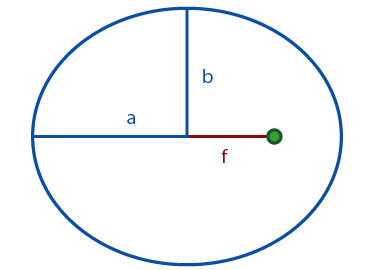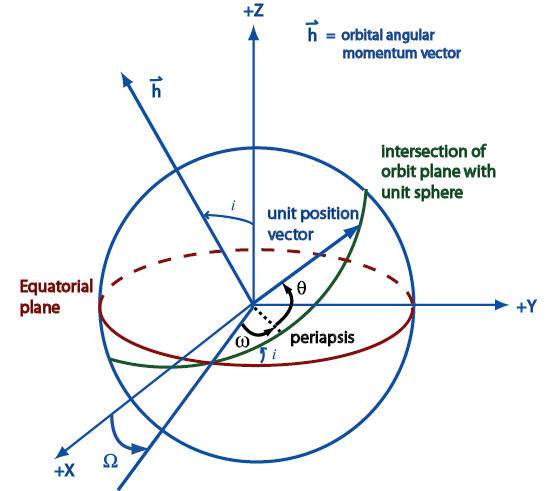- java.lang.Object
-
- agi.foundation.coordinates.LifetimeElements
-
- All Implemented Interfaces:
- ICloneWithContext
public final class LifetimeElements extends Object implements ICloneWithContext
A set of elements produced by theLifetimeOrbitPropagatorto represent the approximate mean classical elements associated with the periapsis of each successive orbit over the course of a satellite's lifetime.
-
-
Constructor Summary
Constructors Constructor and Description LifetimeElements(JulianDate epoch, int orbitCount, double semimajorAxis, double semimajorAxisRate, double eccentricity, double eccentricityRate, double inclination, double inclinationRate, double argumentOfPeriapsis, double argumentOfPeriapsisRate, double rightAscensionOfAscendingNode, double rightAscensionOfAscendingNodeRate, double siderealPeriod, double gravitationalParameter)Initialize a set of lifetime orbit elements to represent one orbit pass.
-
Method Summary
All Methods Instance Methods Concrete Methods Modifier and Type Method and Description Objectclone(CopyContext context)Clones this object using the specified context.doublegetArgumentOfPeriapsis()Gets the argument of periapsis of the orbit, in radians.doublegetArgumentOfPeriapsisRate()Gets the current rate of change of theArgumentOfPeriapsis(get), in radians per second.doublegetEccentricity()Gets the eccentricity of the orbit.doublegetEccentricityRate()Gets the current rate of change of theEccentricity(get), in units per second.doublegetGravitationalParameter()Gets the gravitational parameter used for this element set (distance cubed per time squared).doublegetInclination()Gets the inclination of the orbit, in radians.doublegetInclinationRate()Gets the current rate of change of theInclination(get), in radians per second.intgetOrbitCount()Gets the number of orbits produced by the propagator from the initial conditions to the current elements.doublegetRightAscensionOfAscendingNode()Gets the right ascension of the ascending node of the orbit, in radians.doublegetRightAscensionOfAscendingNodeRate()Gets the current rate of change of theRightAscensionOfAscendingNode(get), in radians per second.doublegetSemimajorAxis()Gets the semimajor axis of the orbit, in meters.doublegetSemimajorAxisRate()Gets the current rate of change of theSemimajorAxis(get), in meters per second.doublegetSiderealPeriod()Gets the approximate orbit period, in seconds, for the current orbit pass.JulianDategetTimeOfPeriapsis()Gets the time at the periapsis of this orbit pass.KeplerianElementstoKeplerianMeanElements()Convert these elements to an equivalentKeplerianElementsrepresentation at the periapsis.
-
-
-
Constructor Detail
-
LifetimeElements
public LifetimeElements(@Nonnull JulianDate epoch, int orbitCount, double semimajorAxis, double semimajorAxisRate, double eccentricity, double eccentricityRate, double inclination, double inclinationRate, double argumentOfPeriapsis, double argumentOfPeriapsisRate, double rightAscensionOfAscendingNode, double rightAscensionOfAscendingNodeRate, double siderealPeriod, double gravitationalParameter)
Initialize a set of lifetime orbit elements to represent one orbit pass.The classification of the
OrbitTypeis exact so that if the user wants this instance ofKeplerianElementsto be classified as a Circular orbit, theeccentricitymust be exactly zero. For parabolic or hyperbolic orbits, seeModifiedKeplerianElements.- Parameters:
epoch- The time at periapsis.orbitCount- The number of orbits, including this one, since the reference epoch.semimajorAxis- Semimajor axis, in meters.semimajorAxisRate- The rate of change of the semimajor axis, in meters per second.eccentricity- Eccentricity.eccentricityRate- The rate of change of the eccentricity, in units per second.inclination- Inclination, in radians.inclinationRate- The rate of change of the inclination, in radians per second.argumentOfPeriapsis- Argument of periapsis, in radians.argumentOfPeriapsisRate- The rate of change of the argument of periapsis, in radians per second.rightAscensionOfAscendingNode- Right ascension of the ascending node, in radians.rightAscensionOfAscendingNodeRate- The rate of change of the right ascension of the ascending node, in radians per second.siderealPeriod- The time required to make one full orbit with respect to inertial space, in seconds.gravitationalParameter- Gravitational parameter (meters cubed per second squared).- Throws:
ArgumentOutOfRangeException- The given elements must represent a closed orbit. The exception is thrown if the eccentricity is negative, not below unity, or if the semimajor axis is not finitely positive. For other orbit types, useModifiedKeplerianElements.ArgumentOutOfRangeException- The semimajor axis cannot be zero or nearly zero. Thrown ifsemimajorAxisis <Constants.Epsilon8.ArgumentOutOfRangeException- Thrown if theinclinationis less than zero or greater than Pi radians.
-
-
Method Detail
-
clone
public final Object clone(CopyContext context)
Clones this object using the specified context.This method should be implemented to call a copy constructor on the class of the object being cloned. The copy constructor should take the
CopyContextas a parameter in addition to the existing instance to copy. The copy constructor should first callCopyContext.addObjectMapping(T, T)to identify the newly constructed instance as a copy of the existing instance. It should then copy all fields, usingCopyContext.updateReference(T)to copy any reference fields.A typical implementation of
ICloneWithContext:public static class MyClass implements ICloneWithContext { public MyClass(MyClass existingInstance, CopyContext context) { context.addObjectMapping(existingInstance, this); someReference = context.updateReference(existingInstance.someReference); } @Override public final Object clone(CopyContext context) { return new MyClass(this, context); } private Object someReference; }In general, all fields that are reference types should be copied with a call to
CopyContext.updateReference(T). There are a couple of exceptions:- Fields that are aggregate parts of the object should always be copied. A referenced object is an aggregate if properties or methods on the object being copied can modify the externally-visible value of the referenced object.
- If the semantics of the referenced object require that it have a single parent, owner, context, etc., and the object being copied is that parent, owner, or context, then the referenced object should always be copied.
If one of these exceptions applies, the
CopyContextshould be given an opportunity to update the reference before the reference is copied explicitly. UseCopyContext.updateReference(T)to update the reference. IfCopyContext.updateReference(T)returns the original object, indicating that the context does not have a replacement registered, then copy the object manually by invoking a Clone method, a copy constructor, or by manually constructing a new instance and copying the values.alwaysCopy = context.updateReference(existingInstance.alwaysCopy); if (existingInstance.alwaysCopy != null && alwaysCopy == existingInstance.alwaysCopy) { alwaysCopy = (AlwaysCopy) existingInstance.alwaysCopy.clone(context); }If you are implementing an evaluator (a class that implements
IEvaluator), theIEvaluator.updateEvaluatorReferences(agi.foundation.infrastructure.CopyContext)method shares some responsibilities with the copy context constructor. Code duplication can be avoided by doing the following:-
For references to other evaluators ONLY, simply assign the reference in the constructor instead of calling
CopyContext.updateReference(T). You should still callCopyContext.updateReference(T)on any references to non-evaluators. -
Call
IEvaluator.updateEvaluatorReferences(agi.foundation.infrastructure.CopyContext)as the last line in the constructor and pass it the sameCopyContextpassed to the constructor. -
Implement
IEvaluator.updateEvaluatorReferences(agi.foundation.infrastructure.CopyContext)as normal. See the reference documentation forIEvaluator.updateEvaluatorReferences(agi.foundation.infrastructure.CopyContext)for more information on implementing that method.
public MyClass(MyClass existingInstance, CopyContext context) { super(existingInstance, context); someReference = context.updateReference(existingInstance.someReference); evaluatorReference = existingInstance.evaluatorReference; updateEvaluatorReferences(context); } @Override public void updateEvaluatorReferences(CopyContext context) { evaluatorReference = context.updateReference(evaluatorReference); } @Override public Object clone(CopyContext context) { return new MyClass(this, context); } private Object someReference; private IEvaluator evaluatorReference;- Specified by:
clonein interfaceICloneWithContext- Parameters:
context- The context to use to perform the copy.- Returns:
- A new instance which is a copy of this object.
-
getTimeOfPeriapsis
@Nonnull public final JulianDate getTimeOfPeriapsis()
Gets the time at the periapsis of this orbit pass.
-
getOrbitCount
public final int getOrbitCount()
Gets the number of orbits produced by the propagator from the initial conditions to the current elements.
-
getSemimajorAxis
public final double getSemimajorAxis()
Gets the semimajor axis of the orbit, in meters. Semimajor axis represents half the distance between the periapsis and the apoapsis.
-
getEccentricity
public final double getEccentricity()
Gets the eccentricity of the orbit.Eccentricity e can be calculated on the basis of semimajor axis a and semiminor axis b as follows:
e = sqrt(1 - (b / a)^2)Referring to the following diagram,
ecan also be expressed asa / f, wherefis the distance from the center of the ellipse to the center of mass of the central body:
-
getInclination
public final double getInclination()
Gets the inclination of the orbit, in radians.The inclination of the orbit is its tilt with reference to the Equatorial plane, or, in the diagram below, the angle i between the central body's spin (Z) axis and the orbit's angular momentum vector.

In the above diagram, ω is the argument of periapsis, θ is the true anomaly, and Ω is the right ascension of the ascending node (RAAN).
-
getArgumentOfPeriapsis
public final double getArgumentOfPeriapsis()
Gets the argument of periapsis of the orbit, in radians.The argument of periapsis, ω, is the angular distance between the ascending node and periapsis:

In the above diagram, Ω is the right ascension of the ascending node (RAAN), θ is the true anomaly, and i is the inclination.
-
getRightAscensionOfAscendingNode
public final double getRightAscensionOfAscendingNode()
Gets the right ascension of the ascending node of the orbit, in radians.The ascending node is the point where the satellite crosses the equator moving south to north. In the diagram below, this point is referenced from the +X direction, which points in the Vernal Equinox direction. The angle between the X axis and the ascending node is called the right ascension of the ascending node (RAAN), represented here by Ω.

In the above diagram, ω is the argument of periapsis, θ is the true anomaly, and i is the inclination.
-
getGravitationalParameter
public final double getGravitationalParameter()
Gets the gravitational parameter used for this element set (distance cubed per time squared).
-
getSiderealPeriod
public final double getSiderealPeriod()
Gets the approximate orbit period, in seconds, for the current orbit pass.
-
getEccentricityRate
public final double getEccentricityRate()
Gets the current rate of change of theEccentricity(get), in units per second.
-
getSemimajorAxisRate
public final double getSemimajorAxisRate()
Gets the current rate of change of theSemimajorAxis(get), in meters per second.
-
getInclinationRate
public final double getInclinationRate()
Gets the current rate of change of theInclination(get), in radians per second.
-
getArgumentOfPeriapsisRate
public final double getArgumentOfPeriapsisRate()
Gets the current rate of change of theArgumentOfPeriapsis(get), in radians per second.
-
getRightAscensionOfAscendingNodeRate
public final double getRightAscensionOfAscendingNodeRate()
Gets the current rate of change of theRightAscensionOfAscendingNode(get), in radians per second.
-
toKeplerianMeanElements
public final KeplerianElements toKeplerianMeanElements()
Convert these elements to an equivalentKeplerianElementsrepresentation at the periapsis.- Returns:
- The approximate mean orbital elements of the current orbit pass.
-
-